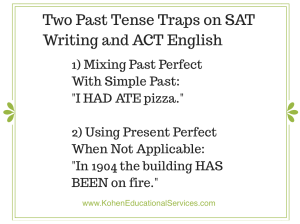The SAT and ACT feature two traps designed to test your knowledge of past tense verbs. You’re likely to see both of these on test day.
The first concerns the two most basic past tenses: the simple past and the past perfect.
The simple past is formed from only one word and is used for an action that happened only in the past. Here are some examples:
I was hungry.
I ate the pizza.
We went to the movie.
The past perfect is used to indicate that a past action occurred before some other past action. It is formed by combining “had” with the past participle of the verb. Here are some examples:
I ate the pizza because I had been hungry.
We took a nap because we had done a lot that day.
In the first example, the subject was hungry before he ate the pizza. In the second example, the subjects did a lot before they took a nap. You could also use the simple past in both of these examples, but the past perfect makes the temporal relationship between the verbs more clear.
To trick you, the SAT and ACT will incorrectly combine the simple past and past perfect into one tense. Here’s how they do it:
“Had” + “simple past form” [INCORRECT]
“I had ate” [INCORRECT]
In this example, the sentence needs to be changed to “I had eaten,” which correctly pairs the past participle (eaten), not the simple past (ate), with “had.”
Anytime you see the auxiliary verb “had” combined with another verb, make sure that the verb is in the past perfect form rather than the simple past. For some verbs these forms are identical (I looked at the book – I had looked at the book), but for others they’re different (I wrote a book – I had written a book).
The second common past tense trap concerns the present perfect tense. The present perfect is used to describe something that began in the past and continues into the present. It’s formed by combining “has/have” with the past participle of the verb. Here are some examples:
Mary has been wealthy a long time.
We have run the race every year.
In the first example, Mary became wealthy sometime in the past and continues to be wealthy into the present. In the second example, the subjects started running the race sometime in the past and have continued to do so up to the present year.
The SAT and ACT love to incorrectly use the present perfect for an action that only occurred in the past and cannot continue into the present. Here’s what this looks like:
In 1904 the building has been on fire. [INCORRECT]
The present perfect is incorrect here because the sentence indicates that the action occurred in 1904, not from 1904 up to the present. If that’s what we wanted to convey, we could write:
Since 1904 the building has been on fire. [CORRECT]
Anytime you see a verb in present perfect form on the SAT or ACT, make sure that the sentence truly describes an action that began in the past and is continuing into the present.
Always be on the lookout for both of these traps when you take the test. An easy way to do this is to watch for had and has/have. If a sentence features a verb with had, make sure it takes the past participle rather than the simple past. If a sentence features a verb with has/have, make sure it makes sense to say that the action began in the past and is continuing into the present.
